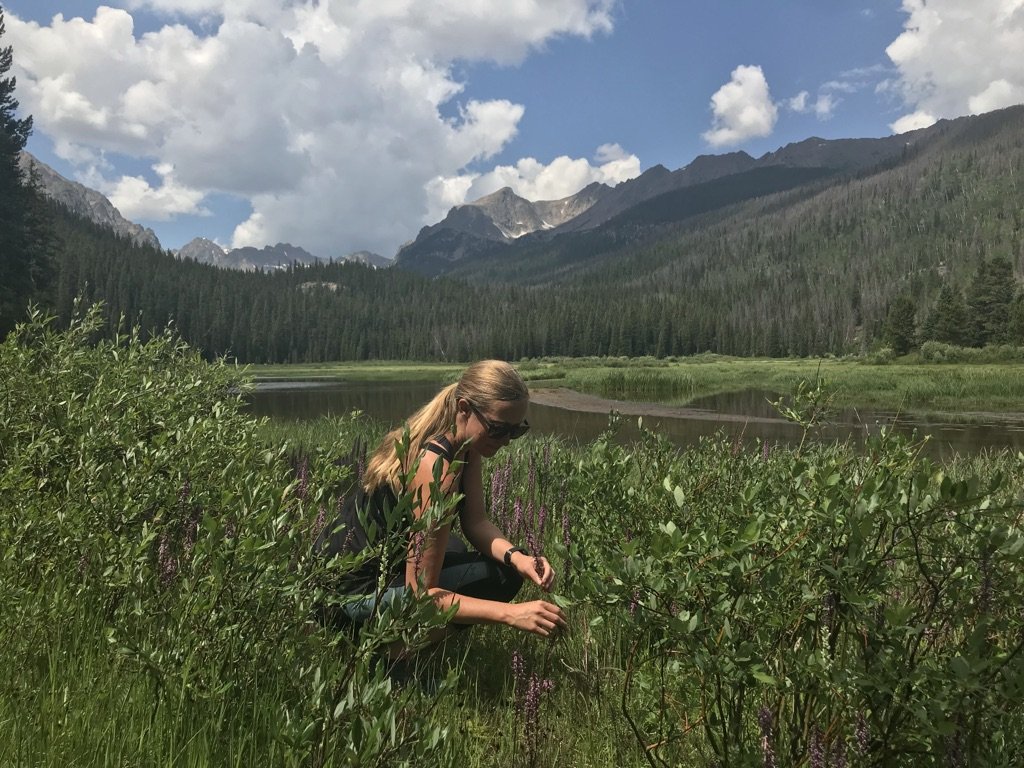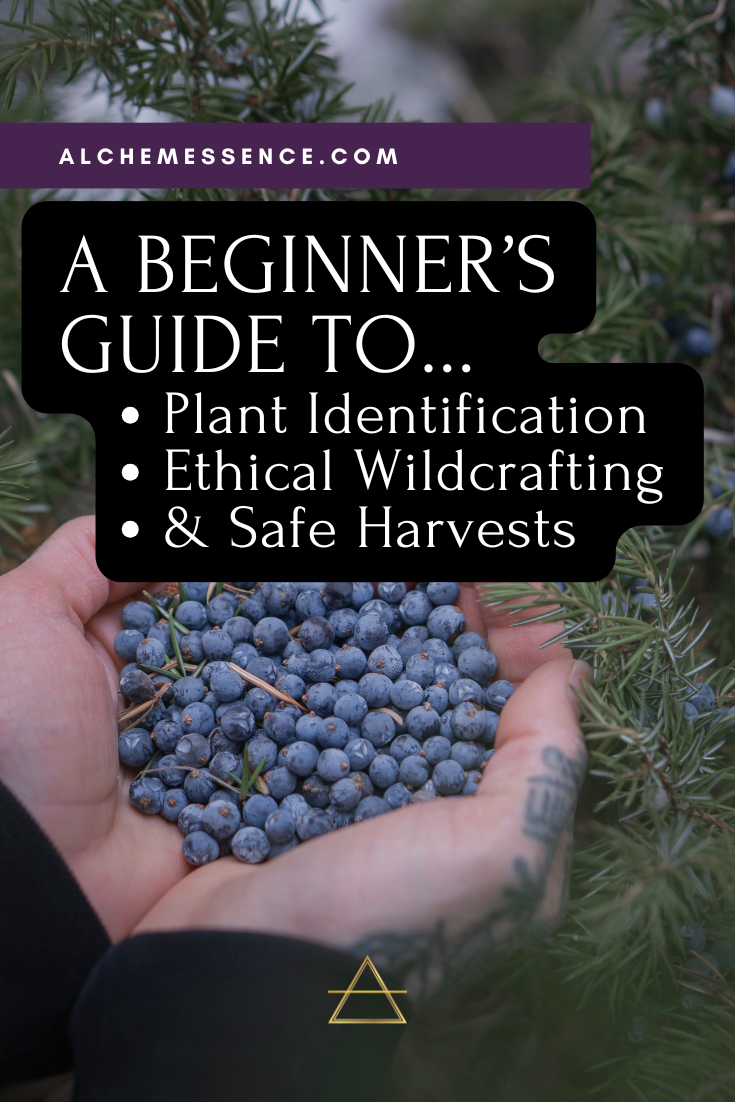A Beginner’s Guide to Plant Identification and Safe Wildcrafting
Foraging for wild plants is one of my absolute favorite ways to connect with nature, deepen your relationship with plant spirits, and access healing right from the land. It’s central to so much of the rewilding work I share.
But before you head out with your gathering basket, it’s essential to learn how to identify plants safely and harvest them ethically. This guide will help you get started on your journey into plant identification and wildcrafting with mindfulness and respect.
Wildcrafting Requires Knowledge and Care
Wildcrafting — the practice of gathering plants from their natural habitats — can be incredibly rewarding, but it carries responsibilities. Misidentification can be dangerous, and overharvesting can harm delicate ecosystems. As stewards of the earth, we must approach wildcrafting with care, patience, and reverence.
Perhaps the number one thing I like to keep in mind: The land needs plants more than you do.
This is a little controversial on the surface — after all, we literally do need plants in order to survive!
But here’s what I mean: Right now, with our modern lives the way they are, we actually don’t need to go out get wild plants in order to survive. We can buy food and medicine in grocery stores, grow potted plants, and tend sustainable gardens.
For this reason, I feel that anything you harvest from a wild area — be it a forest, desert, coast, or other ecosystem — is a gift and a luxury.
And you are worthy of gifts and luxuries!
And — forest foods are not luxuries to the wildlife that depend on them for survival. They are not luxuries to the ecosystems that need them for balance.
Those fragrant wild rose blossoms? As lovely as they are in teas and other elixirs, they are also important food sources for pollinators, who draw birds to the area. And those summer blooms don’t just disappear when the cold comes — they become red, juicy rosehips, another vital winter food source for so many of our animal friends.
I believe that the spirits of nature delight when humans delight in the beauty and abundance of the wilds. A relationship goes two ways, and we are meant to receive joyfully from the Earth. We just must do so with reverence and awareness of our role in every ecosystem.
With that said, let’s dive into safe and ethical wildcrafting :)
Learning to Identify Plants Safely
Proper plant identification is the most important skill you can develop as a beginner. Here’s how to ensure you’re gathering the right plant and not a toxic lookalike:
My number one tip for plant identification? Use multiple guides.
Invest in a few reputable field guides specific to your region. Photographs, botanical drawings, and descriptions will help you recognize key plant characteristics. I like to use a combination of online and printed resources:
Favorite books: the Peterson’s guides and any book from Timber Press’s Medicinal Plants series
Seek app by iNaturalist: While you should never use an app alone for identification, it can at least help narrow down your options. Note the plant families identified, then compare with a deeper look at the botany, region, and lookalikes to confirm your identification.
Online sites: Yes, you need to be careful in the wild west of online info — but there are sooo many great plant identification sites and YouTube channels, many with even more in-depth pictures than printed guides. Look for reputable sites like those from botanical gardens, university extension offices, and longtime herbal teachers (without a bunch of ads on their sites).
My next big tip? Keep revisiting the same plants throughout the seasons.
Walk slowly in silence. Take pictures. Make notes. Get to know the same plants again and again throughout the year. Here are a few tips to help you know your plant neighbors:
Observe All Plant Features – Examine leaves, stems, flowers, seeds, and roots. Many plants look similar at a glance but have distinct characteristics upon closer inspection. Use a botany book to help you identify subtle differences.
Pay Attention to Habitat – Certain plants only grow in specific conditions. If a plant is out of place, double-check its identity.
Smell and Touch (with Caution) – Some plants have unique scents or textures that help with identification — smell is how our ancestors navigated so much of the plant world. But this one has a few important cautions:
Several plants are known to cause allergic reactions or rashes just by touching them. Research the potentially poison plants in your area, so you know what to avoid.
Even plants that are not poisonous can cause dermatological reactions and sun sensitivity in different folks, so know your own sensitivity levels and start very small with touch.
And never taste a plant unless you are absolutely certain of its identity!
Finally, the best advice? Learn from local experts.
Join a foraging group or take a class with an experienced herbalist to gain hands-on knowledge. You can often find free or very affordable plant walks to join.
This is how I got my start oh so many years ago (with the amazing Brigit Mars). There’s nothing like getting to know plants in person with a person ;)
Ok — one more piece of advice: Start slow.
There are magical, healing plants everywhere! So many green friends to meet :) When I hiking along a forest trail, I literally feel like I’m walking through a pharmacy or grocery store.
But it took me a looong time to get here.
I started by revisiting the same trails again and again throughout the year. Each time, I might remember and learn about one or two more plants I noticed. Then I might forget, and remember those two plants again with the next visit, and then add a third to my repertoire.
Going slow lets the plant wisdom seep deep into you, so you embody your knowledge fully. This is the foundation of true spiritual plant wisdom. It’s not a huge list of plants or a big library of identification books (though those are lovely to have). It’s a slow, authentically cultivated relationship with plants that you know inside and out.
Ethical and Sustainable Wildcrafting
Once you’ve properly identified a plant, the next step is to harvest with care, reverence, and strong ethical foundations. My number one perameter for ethical harvesting is above — the health of the forest comes first.
These additional guidelines will help you ensure that wild populations remain healthy for generations to come:
Harvest with Permission – Permission from both the plants and people involved.
If gathering on private land, ask for permission. In public spaces, check regulations before foraging. Get permits as necessary, and respect restrictions in wilderness areas — these are in place for a reason.
And remember that permission from the spirits of nature, the land guardians, and the plant itself are primary. This is something I cover in much more depth in Rewilding the Spirit.
Follow the ‘One in Twenty’ Rule – A general rule of foraging is to only harvest if at least twenty plants are present in the area, and never take more than 5-10% of a stand. While this is a good guideline in general, you really need to trust your intuition and look at the unique circumstances around you.
For example, if you’re in a field of dandelions or another invasive species — harvesting to your heart’s content might actually help the ecosystem, even if you take way more than 10%.
But if that area is frequented by many wildcrafters, leaving some for others is important.
Or, maybe you find a patch of wild roses that is super abundant…but it’s the only patch for miles around. In this case, perhaps nibbling on just a petal or two is most appropriate.
The more you can venture out with more experienced folks, the more these ethical guidelines will become natural to you.
Leave No Trace – Avoid trampling surrounding plants and habitats. Refill holes where roots were dug. When you look back at where you gathered, it should look as if you were never there and nothing was taken.
Harvest Mindfully and Kindly – Before taking any plants, learn how to obtain them without damaging or causing harm. With berries, this might be as simple as picking them, while stems and leaves should be clipped at the appropriate areas with sharp, clean clippers. Bark should not be harvested without expert training. Harvesting roots can kill the plant and requires special care.
Give Back – Reciprocity is at the heart of ethical wildcrafting. Leaving offerings, singing to the land, returning plant material to be composted where it was gathered, scattering appropriate seeds, and becoming a steward of the Earth in all of life are keys.
Pay Attention to Environmental Contamination
Before harvesting, consider the quality of the land where the plant is growing. Many areas are contaminated with pollutants that can be absorbed by plants, making them unsafe for use.
Avoid roadside foraging – Plants growing near busy roads can accumulate heavy metals and other pollutants from vehicle emissions.
Be cautious near industrial sites – Old factories, railways, and mining areas may have lingering chemical contamination in the soil.
Watch for pesticide use – Parks, golf courses, and agricultural fields are often treated with pesticides and herbicides that can make plants toxic.
Know your water sources – Plants growing near polluted rivers, storm drains, or runoff areas may be unsafe due to waterborne contaminants.
Test the soil if unsure – If you plan to harvest regularly from a location, consider testing the soil for heavy metals or toxins.
Dog pee is a thing – Plants by signs and corners along trails or in parks can be prime spots for pee piles.
Building a Relationship with Plants
Foraging isn’t just about gathering—it’s about forming a relationship with the plants and the land. Spend time observing plants in different seasons, sit with them in meditation, and listen to their wisdom. Many traditional herbalists and plant spirit practitioners believe that plants offer guidance to those who approach with respect and an open heart.
I believe these relationships are best built in community — both with each other and with the greater world of nature spirits. This is exactly what we’ll be doing in Rewilding the Spirit this summer. This program only opens once a year and it is deep.
Wildcrafting is a beautiful way to connect with nature and experience plant healing firsthand. By practicing careful identification, ethical harvesting, and safe preparation, you can develop a deeper, more reciprocal relationship with the plant world. May your plant adventures be filled with wisdom, wonder, and gratitude!
Enjoyed this article? The absolute most wonderful way to say thank you is by sharing it! Use the image below for Pinterest or add to all your socials :)
ASTROLOGY | RECIPES | REWILDING | SACRED AROMATICS | SHAMANISM | SPIRITUALITY | WELLNESS
Juniper Stokes is a certified coach, mythoanimist guide, alchemist & artist.




